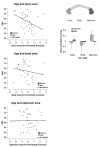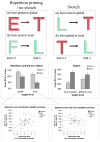Local-global interference is modulated by age, sex and anterior corpus callosum size
- PMID: 17335783
- PMCID: PMC1876662
- DOI: 10.1016/j.brainres.2007.01.062
Local-global interference is modulated by age, sex and anterior corpus callosum size
Abstract
To identify attentional and neural mechanisms affecting global and local feature extraction, we devised a global-local hierarchical letter paradigm to test the hypothesis that aging reduces functional cerebral lateralization through corpus callosum (CC) degradation. Participants (37 men and women, 26-79 years) performed a task requiring global, local, or global+local attention and underwent structural MRI for CC measurement. Although reaction time (RT) slowed with age, all participants had faster RTs to local than global targets. This local precedence effect together with greater interference from incongruent local information and greater response conflict from local targets each correlated with older age and smaller callosal genu (anterior) areas. These findings support the hypothesis that the CC mediates lateralized local-global processes by inhibition of task-irrelevant information under selective attention conditions. Further, with advancing age smaller genu size leads to less robust inhibition, thereby reducing cerebral lateralization and permitting interference to influence processing. Sex was an additional modifier of interference, in that callosum-interference relationships were evident in women but not in men. Regardless of age, smaller splenium (posterior) areas correlated with less response facilitation from repetition priming of global targets in men, but with greater response facilitation from repetition priming of local targets in women. Our data indicate the following dissociation: anterior callosal structure was associated with inhibitory processes (i.e., interference from incongruency and response conflict), which are vulnerable to the effects of age and sex, whereas posterior callosal structure was associated with facilitation processes from repetition priming dependent on sex and independent of age.
Figures





Similar articles
-
Callosal degradation in HIV-1 infection predicts hierarchical perception: a DTI study.Neuropsychologia. 2010 Mar;48(4):1133-43. doi: 10.1016/j.neuropsychologia.2009.12.015. Epub 2009 Dec 16. Neuropsychologia. 2010. PMID: 20018201 Free PMC article.
-
Global-local interference is related to callosal compromise in alcoholism: a behavior-DTI association study.Alcohol Clin Exp Res. 2009 Mar;33(3):477-89. doi: 10.1111/j.1530-0277.2008.00858.x. Epub 2008 Dec 13. Alcohol Clin Exp Res. 2009. PMID: 19120053 Free PMC article.
-
Does white matter matter? Spatio-temporal dynamics of task switching in aging.J Cogn Neurosci. 2009 Jul;21(7):1380-95. doi: 10.1162/jocn.2009.21093. J Cogn Neurosci. 2009. PMID: 18752402 Free PMC article.
-
Sex differences in the human corpus callosum: myth or reality?Neurosci Biobehav Rev. 1997 Sep;21(5):581-601. doi: 10.1016/s0149-7634(96)00049-8. Neurosci Biobehav Rev. 1997. PMID: 9353793 Review.
-
How does the corpus callosum mediate interhemispheric transfer? A review.Behav Brain Res. 2011 Sep 30;223(1):211-21. doi: 10.1016/j.bbr.2011.04.018. Epub 2011 Apr 21. Behav Brain Res. 2011. PMID: 21530590 Review.
Cited by
-
Functional implications of age differences in motor system connectivity.Front Syst Neurosci. 2010 Jun 7;4:17. doi: 10.3389/fnsys.2010.00017. eCollection 2010. Front Syst Neurosci. 2010. PMID: 20589101 Free PMC article.
-
Missing the big picture: impaired development of global shape processing in autism.Autism Res. 2008 Apr;1(2):114-29. doi: 10.1002/aur.17. Autism Res. 2008. PMID: 19360658 Free PMC article.
-
Longitudinal study of callosal microstructure in the normal adult aging brain using quantitative DTI fiber tracking.Dev Neuropsychol. 2010;35(3):233-56. doi: 10.1080/87565641003689556. Dev Neuropsychol. 2010. PMID: 20446131 Free PMC article. Review.
-
Neuroanatomical substrates of age-related cognitive decline.Psychol Bull. 2011 Sep;137(5):753-84. doi: 10.1037/a0023262. Psychol Bull. 2011. PMID: 21463028 Free PMC article. Review.
-
Sex differences in implicit processing of allocentric relationships between objects and location in a Simon task.PLoS One. 2020 Jul 22;15(7):e0235964. doi: 10.1371/journal.pone.0235964. eCollection 2020. PLoS One. 2020. PMID: 32697771 Free PMC article.
References
-
- Aboitiz F, Scheibel AB, Zaidel E. Morphometry of the Sylvian fissure and the corpus callosum, with emphasis on sex differences. Brain. 1992;115:1521–1541. - PubMed
-
- American Psychiatric Association. Diagnostic and Statistical Manual of Mental Disorders. 4. American Psychiatric Press; Washington, DC: 1994.
-
- Anderson ND, Iidaka T, Cabeza R, Kapur S, McIntosh AR, Craik FI. The effects of divided attention on encoding- and retrieval-related brain activity: A PET study of younger and older adults. J Cogn Neurosci. 2000;12:775–792. - PubMed
-
- Banich MT, Belger A. Interhemispheric interaction: how do the hemispheres divide and conquer a task? Cortex. 1990;26:77–94. - PubMed
-
- Banich MT, Goering S, Stolar N, Belger A. Interhemispheric processing in left- and right-handers. Int J Neurosci. 1990;54:197–208. - PubMed
Publication types
MeSH terms
Grants and funding
LinkOut - more resources
Full Text Sources
Medical

